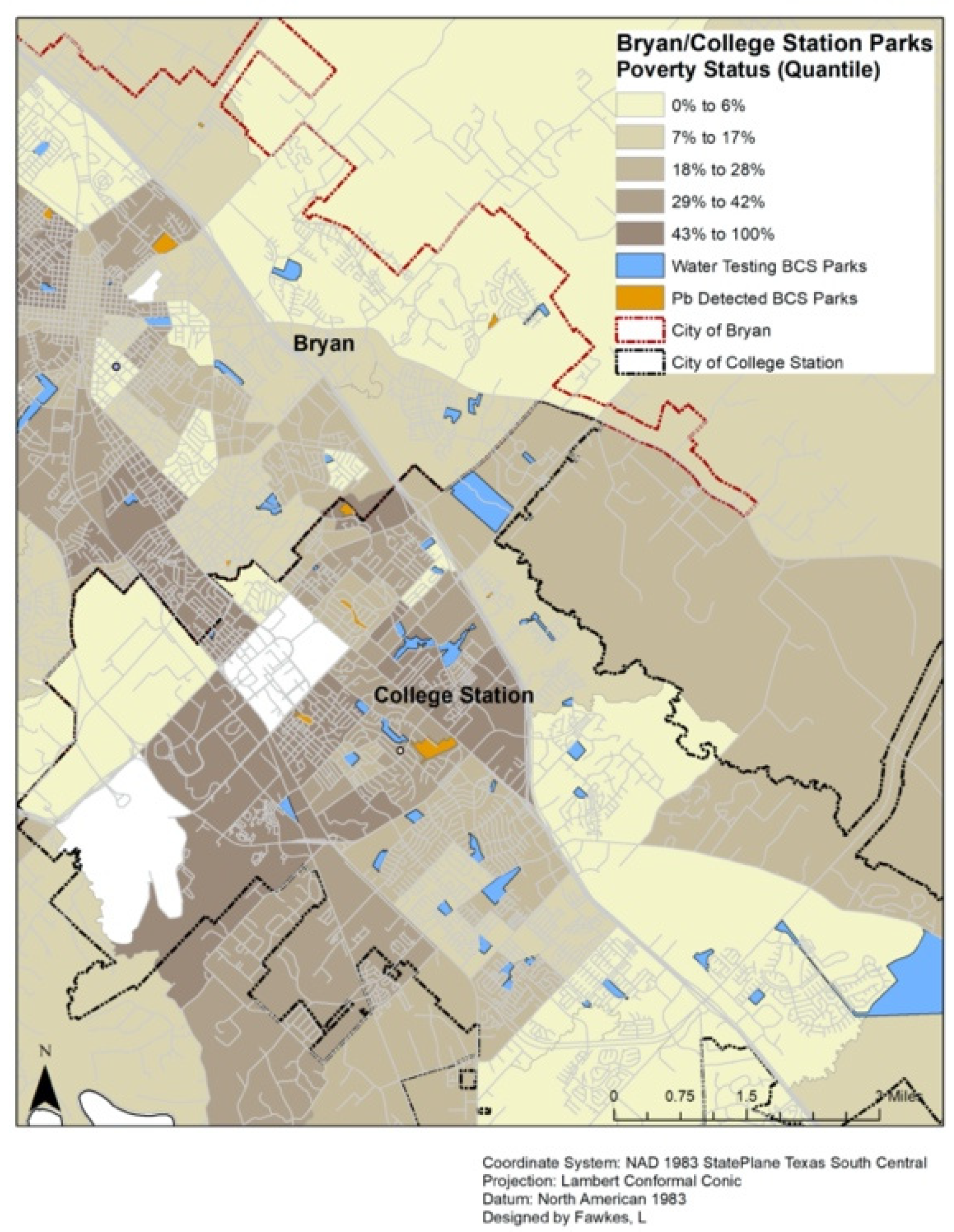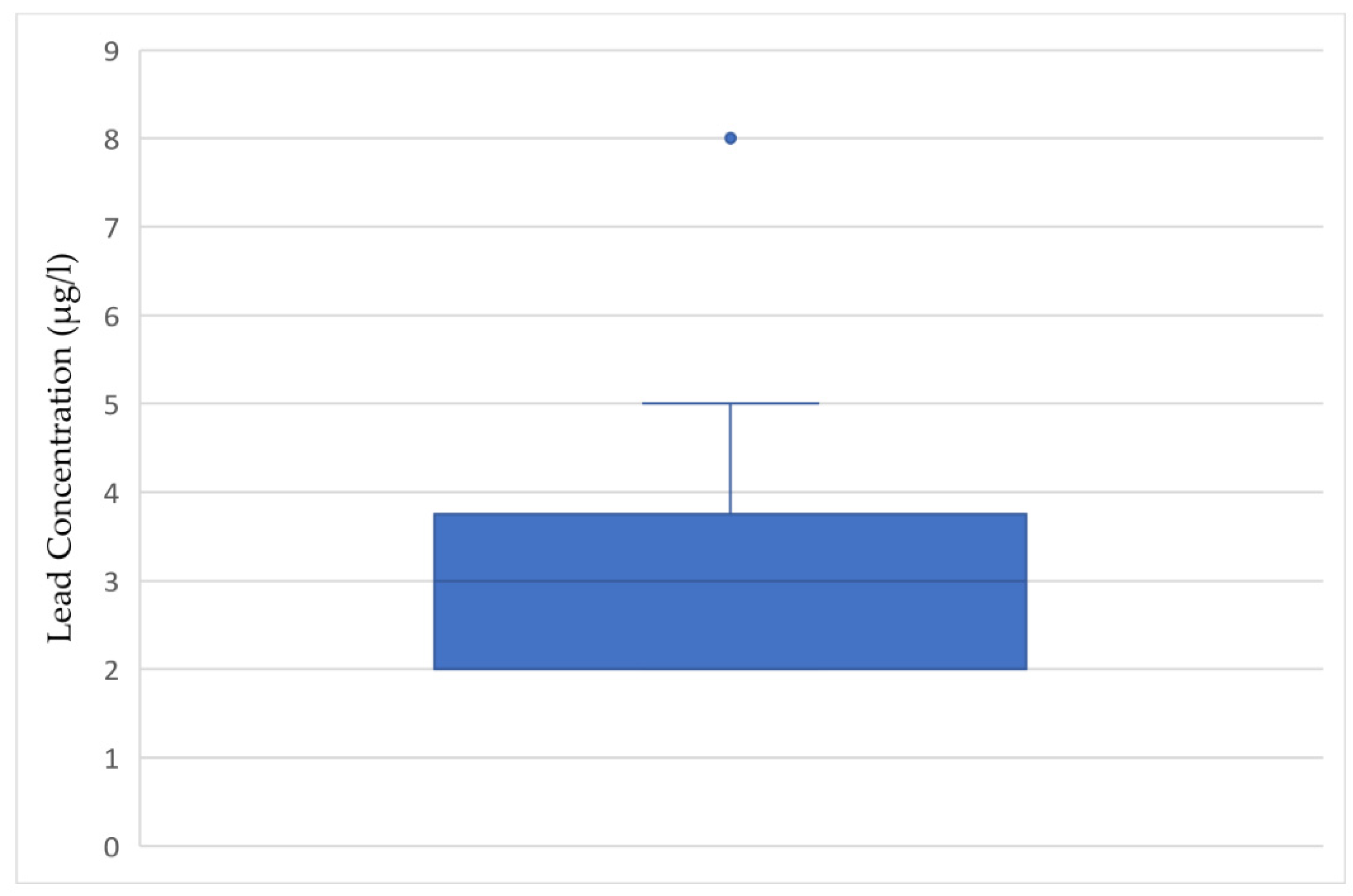Preliminary Study of Lead-Contaminated Drinking Water in Public Parks—An Assessment of Equity and Exposure Risks in Two Texas Communities
Abstract
1. Introduction
2. Materials and Methods
2.1. Study Location
2.2. Drinking Water Sampling
3. Results
4. Discussion
5. Practical Implications
6. Conclusions
Author Contributions
Funding
Institutional Review Board Statement
Informed Consent Statement
Data Availability Statement
Conflicts of Interest
References
- World Health Organization, International Agency for Research on Cancer. Summary of Data Reported and Evaluation. In Inorganic and Organic Lead Compounds: IARC Monographs on the Evaluation of Carcinogenic Risk to Humans; International Agency for Research on Cancer: Lyon, France, 2006; Volume 87. [Google Scholar]
- Davis, A.D.; Webb, C.J.; Sorensen, J.L.; Dixon, D.J.; Hudson, R. Geochemical thermodynamics of lead removal from water with limestone. WaterAir Soil Pollut. 2018, 229, 177. [Google Scholar] [CrossRef]
- Benfer, E.A. Contaminated childhood: How the United States failed to prevent the chronic lead poisoning of low-income children and communities of color. Harv. Environ. Law Rev. 2017, 41, 493–561. [Google Scholar]
- Centers for Disease Control and Prevention. Health Problems Caused by Lead. 2018. Available online: https://www.cdc.gov/niosh/topics/lead/health.html (accessed on 20 October 2020).
- United States Environmental Protection Agency. Lead: Learn About Lead. Available online: https://www.epa.gov/lead/learn-about-lead#effects (accessed on 20 October 2020).
- Agency for Toxic Substances & Disease Registry. Lead Toxicity What Are Possible Health Effects from Lead Exposure? 2017. Available online: https://www.atsdr.cdc.gov/csem/csem.asp?csem=34&po=10 (accessed on 15 November 2020).
- Toxicological Profile for Lead; Agency for Toxic Substances & Disease Registry: Atlanta, GA, USA, 2019.
- United States Environmental Protection Agency. Ground Water and Drinking Water. Available online: https://www.epa.gov/ground-water-and-drinking-water/national-primary-drinking-water-regulations#seven (accessed on 18 November 2020).
- Council, N.R. Measuring Lead Exposure in Infants, Children, and Other Sensitive Populations; National Academies Press: Washington, DC, USA, 1993. [Google Scholar]
- Sansom, G.; Cizmas, L.; Aarvig, K.; Dixon, B.; Kirsch, K.R.; Katare, A.; Sansom, L. Vulnerable populations exposed to lead-contaminated drinking water within houston ship channel communities. Int. J. Environ. Res. Public Health 2019, 16, 2745. [Google Scholar] [CrossRef] [PubMed]
- Lidsky, T.I.; Schneider, J.S. Lead neurotoxicity in children: Basic mechanisms and clinical correlates. Brain 2003, 126, 5–19. [Google Scholar] [CrossRef] [PubMed]
- Moya, J.; Bearer, C.F.; Etzel, R.A. Children’s behavior and physiology and how it affects exposure to environmental contaminants. Pediatrics 2004, 113, 996–1006. [Google Scholar] [PubMed]
- Bryant, S.D. Lead—Contaminated drinking waters in the public schools of Philadelphia. J. Toxicol. Clin. Toxicol. 2004, 42, 287–294. [Google Scholar] [CrossRef] [PubMed]
- Cech, I.; Smolensky, M.H.; Afshar, M.; Broyles, G.; Barczyk, M.; Burau, K.; Emery, R. Lead and copper in drinking water fountains-Information for physicians. South. Med. J. 2006, 99, 137–143. [Google Scholar] [CrossRef] [PubMed]
- New York City Parks and Recreation. Lead Free NYC: Drinking Fountains. Available online: https://www.nycgovparks.org/about/health-and-safety-guide/lead (accessed on 18 May 2021).
- Theising, A. Lead pipes, prescriptive policy and property values. Environ. Resour. Econ. 2019, 74, 1355–1382. [Google Scholar] [CrossRef]
- Schnoor, J.L. Recognizing Drinking Water Pipes as Community Health Hazards; ACS Publications: Washington, DC, USA, 2016. [Google Scholar]
- Centers for Disease Control and Prevention. Childhood Lead Poisoning Prevention. Available online: https://www.cdc.gov/nceh/lead/prevention/populations.htm (accessed on 2 December 2020).
- Nicholson, J.S. A community-based intervention for low-income families to reduce children’s blood lead levels between 3–9.9 μg/Dl. Child. Health Care 2018, 47, 379–396. [Google Scholar] [CrossRef]
- Binns, H.J.; Campbell, C.; Brown, M.J.; Center for Disease Control and Prevention Advisatory Committee on Childhood Lead Poisoning Prevention. Interpreting and managing blood lead levels of less than 10 μg/dL in children and reducing childhood exposure to lead: Recommendations of the Centers for Disease Control and Prevention Advisory Committee on Childhood Lead Poisoning Prevention. Pediatrics. 2007, 5, e1285–e1298. [Google Scholar] [CrossRef] [PubMed]
- United States Census Bureau. American Community Survey (ACS). 2020. Available online: https://www.census.gov/programs-surveys/acs/ (accessed on 18 January 2021).
- Carrera, J.S.; Key, K.; Bailey, S.; Hamm, J.A.; Cuthbertson, C.A.; Lewis, E.Y.; Woolford, S.J.; DeLoney, E.H.; Greene-Moton, E.; Wallace, K.; et al. Community science as a pathway for resilience in response to a public health crisis in Flint, Michigan. Soc. Sci. 2019, 8, 94. [Google Scholar] [CrossRef]
- City of College Station. Water Quality Report 2019. Available online: https://cstx.gov/UserFiles/Servers/Server_12410832/File/Departments/CSU/Water/DrinkingWaterQualityReport19.pdf (accessed on 2 December 2020).
- Texas Water Development Board. Carrizo-Wilcox Aquifer. Available online: https://www.twdb.texas.gov/groundwater/aquifer/majors/carrizo-wilcox.asp (accessed on 2 December 2020).
- Miranda, M.L.; Kim, D.; Hull, A.P.; Paul, C.J.; Galeano, M.A.O. Changes in blood lead levels associated with use of chloramines in water treatment systems. Environ. Health Perspect. 2007, 115, 221–225. [Google Scholar] [CrossRef] [PubMed]
- Renner, R. Out of Plumb: When Water Treatment Causes Lead Contamination; National Institute of Environmental Health Sciences: Research Triangle Park, NC, USA, 2009. [Google Scholar]
- City of College Station. Water Production & Treatment, Tap Water. Available online: https://www.cstx.gov/departments___city_hall/csu/water/water_production___treatment (accessed on 20 October 2020).
- Houston Chronicle. Bryan Municipal Utilities Water Treatment Plant. 2018. Available online: https://rtk.rjifuture.org/rmp/facility/100000078863 (accessed on 20 October 2020).
- Katner, A.; Pieper, K.J.; Lambrinidou, Y.; Brown, K.; Hu, C.Y.; Mielke, H.W.; Edwards, M.A. Weaknesses in federal drinking water regulations and public health policies that impede lead poisoning prevention and environmental justice. Environ. Justice 2016, 9, 109–117. [Google Scholar] [CrossRef]
- Bryan Water Department, General Rules and Regulations; Bryan Water Department: Bryan, TX, USA, 2009.
- Bryan Co. Parks and Recreation. Parks and Facilities Listings. Available online: https://www.bryantx.gov/parks-and-recreation/parks-and-facilities-listings/ (accessed on 25 October 2020).
- SA 1100 Scanning Analyzer Specification Guidelines. n.d. Available online: https://www.palintest.com/wp-content/uploads/2019/04/SA1100-Scanning-Analyzer.pdf (accessed on 18 January 2021).
- United States Environmental Protection Agency. Proposed Revisions to the Lead and Copper Rule. Available online: https://www.epa.gov/ground-water-and-drinking-water/proposed-revisions-lead-and-copper-rule (accessed on 20 October 2020).
- Salim, R. Adsorption of lead on mud. J. Environ. Sci. Health Part A 1986, 21, 551–560. [Google Scholar] [CrossRef]
- Cajuste, L.; Carri1lo-Gonzalez, R.; Laird, R.; Cajuste, L., Jr. Adsorption of lead and cadmium by some volcanic ash soils. J. Environ. Sci. Health Part A 1996, 31, 339–354. [Google Scholar] [CrossRef]
- Doré, E.; Deshommes, E.; Andrews, R.C.; Nour, S.; Prévost, M. Sampling in schools and large institutional buildings: Implications for regulations, exposure and management of lead and copper. Water Res. 2018, 140, 110–122. [Google Scholar] [CrossRef] [PubMed]
- Parks, J.; Pieper, K.J.; Katner, A.; Tang, M.; Edwards, M. Potential Challenges Meeting the American Academy of Pediatrics’ Lead in School Drinking Water Goal of 1 μg/L. Corrosion 2018, 74, 914–917. [Google Scholar] [CrossRef]


| Characteristics | Bryan | College Station |
|---|---|---|
| Total population | 83,199 | 110,782 |
| Population in poverty (%) | 22.6 | 30.8 |
| Population below 5 years of age (%) | 7.5 | 5.3 |
| Hispanic or Latino population (%) | 39.5 | 15.6 |
| Black or African American population (%) | 15.8 | 7.4 |
| Asian population (%) | 1.9 | 10.4 |
Publisher’s Note: MDPI stays neutral with regard to jurisdictional claims in published maps and institutional affiliations. |
© 2021 by the authors. Licensee MDPI, Basel, Switzerland. This article is an open access article distributed under the terms and conditions of the Creative Commons Attribution (CC BY) license (https://creativecommons.org/licenses/by/4.0/).
Share and Cite
Fawkes, L.; Sansom, G. Preliminary Study of Lead-Contaminated Drinking Water in Public Parks—An Assessment of Equity and Exposure Risks in Two Texas Communities. Int. J. Environ. Res. Public Health 2021, 18, 6443. https://doi.org/10.3390/ijerph18126443
Fawkes L, Sansom G. Preliminary Study of Lead-Contaminated Drinking Water in Public Parks—An Assessment of Equity and Exposure Risks in Two Texas Communities. International Journal of Environmental Research and Public Health. 2021; 18(12):6443. https://doi.org/10.3390/ijerph18126443
Chicago/Turabian StyleFawkes, Leanne, and Garett Sansom. 2021. "Preliminary Study of Lead-Contaminated Drinking Water in Public Parks—An Assessment of Equity and Exposure Risks in Two Texas Communities" International Journal of Environmental Research and Public Health 18, no. 12: 6443. https://doi.org/10.3390/ijerph18126443
APA StyleFawkes, L., & Sansom, G. (2021). Preliminary Study of Lead-Contaminated Drinking Water in Public Parks—An Assessment of Equity and Exposure Risks in Two Texas Communities. International Journal of Environmental Research and Public Health, 18(12), 6443. https://doi.org/10.3390/ijerph18126443





